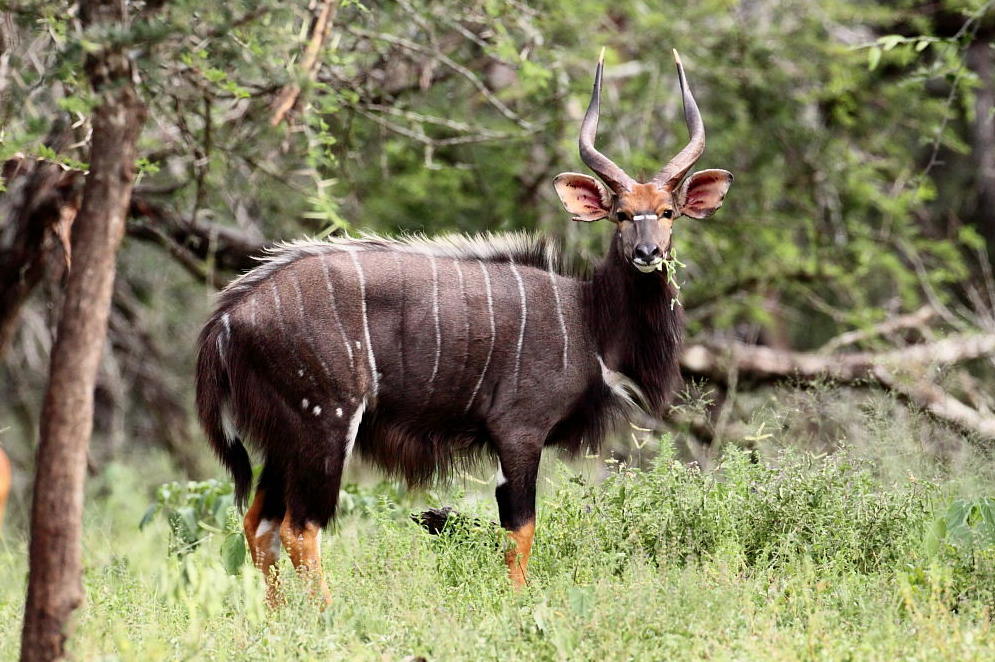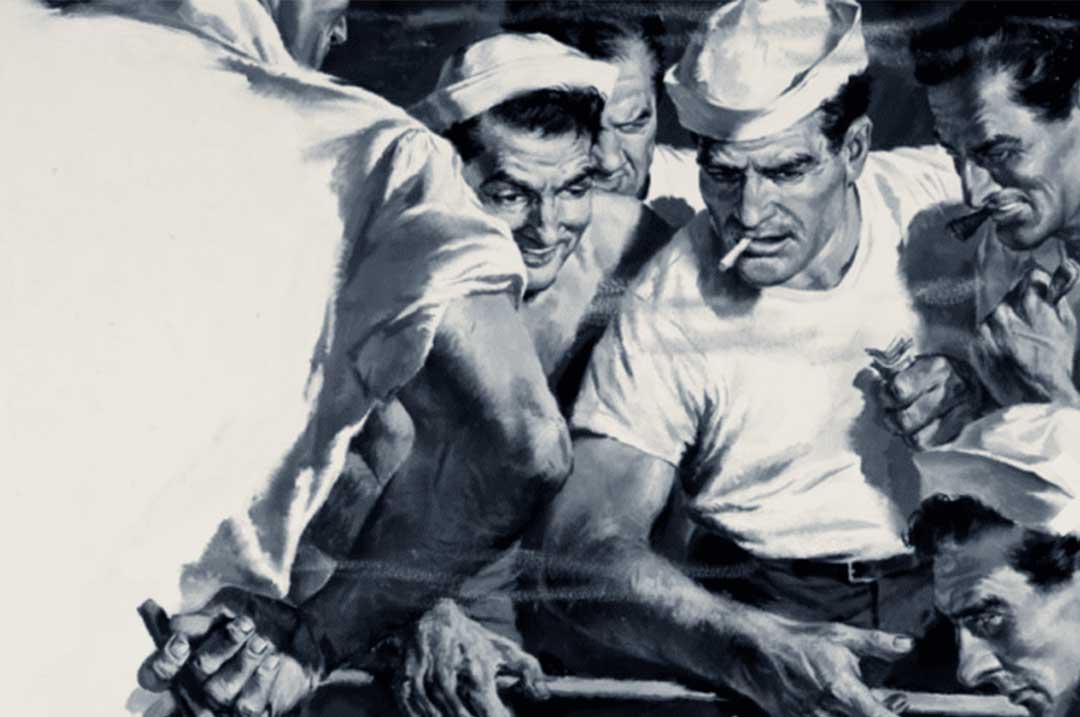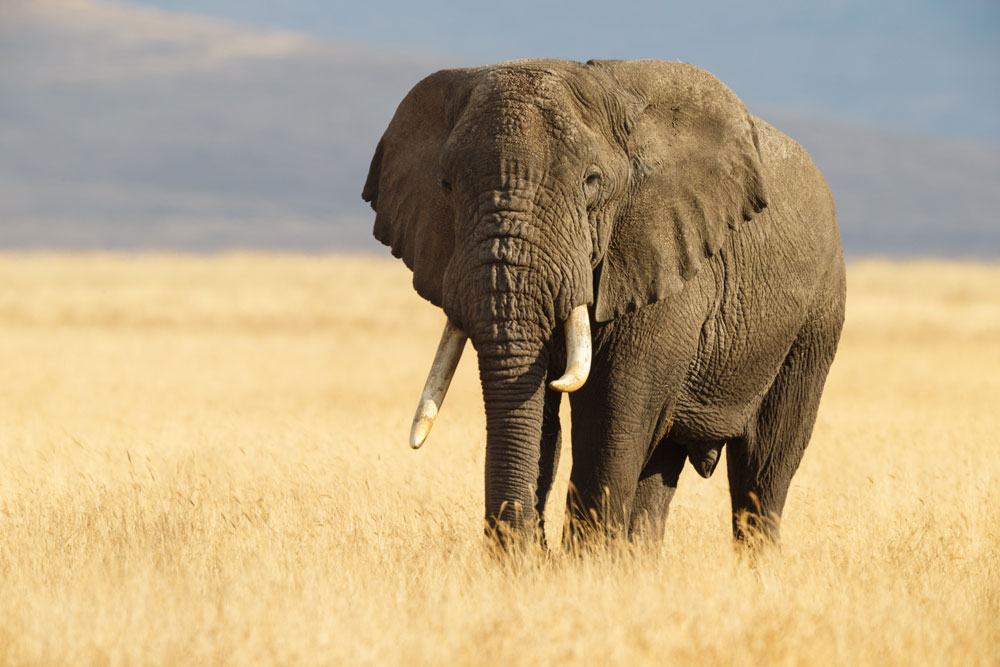Beneath the watchful eyes of the spirits, he would follow his dream of hunting a single species of African game.
Sometimes in the deep of night, when I’m alone with my thoughts, I reflect on the moment. And it’s always the eyes that I remember. Probably because that’s what I saw first. Eyes peering through a cloud of dust, no more than 20 yards away. We had come around a curve in the sandy bush road and slid into the cloud. Theuns, Jimmy and I were riding in the open back, hanging onto the iron rail behind the cab. When the driver hit the brakes hard, the Land Cruiser slewed to the right, so that when we skidded to a stop, I was hanging half-out, looking down on the fracas.
That’s when I saw the eyes. And fawn-colored legs, hanging limply against a background of dark rosettes etched upon a tawny hide. As the dust began to clear, I realized that I was looking at a leopard, crouching with a young impala ram in his jaws. The impala struggled once, convulsed and went limp again, and for several seconds the leopard hunkered, unmoving, staring at the strange, frail-looking intruders before walking into the bush carrying the impala, its head and legs dangling, tracing hunt “drag lines” into the sandy earth.
I remember thinking it strange that they were not the “eyes of a killer” that spatter the literature of Africa. They were impassive and amoral, the eyes of a creature to whom killing comes naturally and easily, harboring neither good nor evil. They held only the reality of the predator. Kill or die. Eat or be eaten. It is the fundamental reality that permeates the soul of Africa, and a reminder that, even at its tamest, Africa is still Africa. And compared to Africa, all the rest of the world is bland.
Two days later I stumbled into Theuns when he stopped abruptly while we were tracing a good nyala bull. We were slipping around the fringe of bush that circled a small waterhole. Again, it was an eye that caught my attention, but this time it was the myopic little pig-eye of a rhino squinting through a thorn bush at about 15 yards. He looked perturbed by our intrusion into his personal space and his equally tiny brain was contemplating the matter of what he should do about it. Fortunately for us, thinking is not the rhino’s strong suit, and we carefully backed away before he reached any conclusion.
Later the same day we had another confrontation, with a huge rhino cow standing in the middle of the sandy road straddling a days-old calf. This time, we had a little more space to work with since the two were about 50 yards away. After about ten minutes, it occurred to mama that she could simply walk away. And she did. Mtoto followed and we were all on our way again.
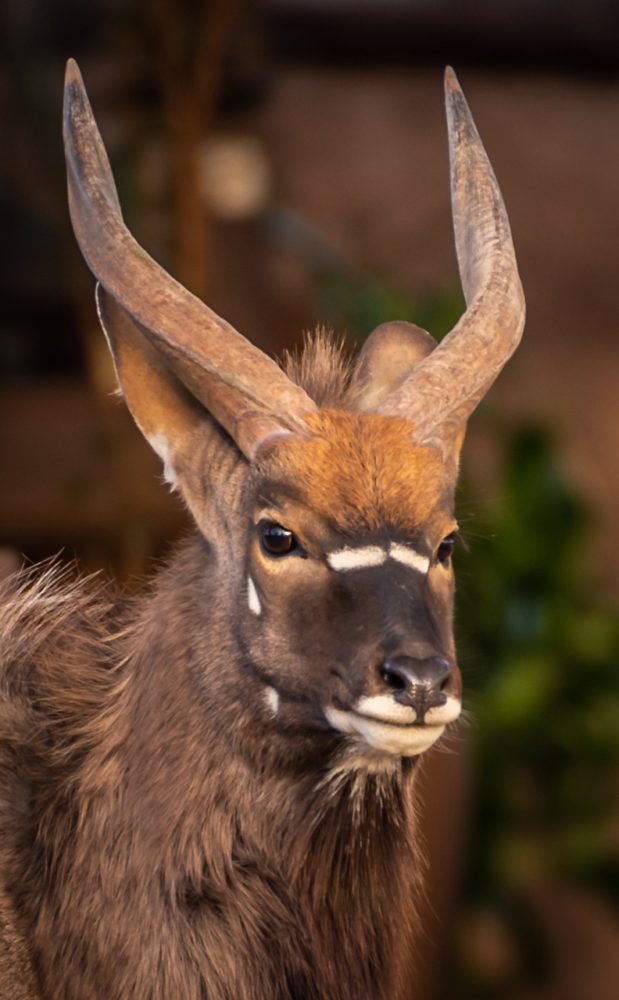 Three days into Africa, we had seen oryx and eland and buffalo and leopard and rhino and kudu and wildebeest. But no shots had been fired. We were hunting nyala.
Three days into Africa, we had seen oryx and eland and buffalo and leopard and rhino and kudu and wildebeest. But no shots had been fired. We were hunting nyala.
It wouldn’t be quite accurate to call nyala an obsession, although it would be a bit more romantic if I could. Perhaps a fascination taken to extreme. I don’t really claim to understand it myself. It isn’t that nyala are all that rare. Not common. But not exactly rare, either. Somewhere along the line, though, a little “mind worm” had worked its way around to being a big thing inside my head, and I wanted to hunt nyala, the beautiful and reclusive, lightly striped, gray-brown cousin to the kudu. The one with the graceful lyre-shaped horns with ivory tips.
Once again, the desire to return to Africa and hunt a single species had grown into a dream.
I had hunted Africa before. For buffalo, the indomitable “black death.” I had hunted kudu, gemsbok, waterbuck and other plains game. But I had never even seen a nyala, except in photographs. And I wanted to.
And so it happened that I found myself alone once again, sitting on my battered green duffel, outside a tiny terminal in a remote corner of the world, waiting for someone that I had never seen and didn’t know, doodling in the dust with the toe of my boot and pondering the imponderable. The place was Polokwane, the capital of Limpopo province, South Africa.
The person turned out to be Theuns Botha. Straight from central casting, my PH was young, tanned and muscular with a shock of close-cropped blond hair and steely blue eyes that perpetually squinted from the merciless South African sun. Fortunately, I didn’t have to wait long. He was as punctual as permitted by the vagaries of African traffic. Even in these times, travelers to Africa must have patience. At its best, Africa still moves at its own pace.
With the Land Cruiser loaded, we turned our backs to town and headed into the bush. In time, houses faded away and the landscape turned to rock and sand and thornbush and mopane, the horizon broken by huge rock kopjes and distant blue mountains. Within a couple of hours we were driving up the red-sand track to Ekland Safaris’ Main Lodge.
I really hadn’t known what to expect when I booked Ekland. I knew only that it was supposed to be nice, and that they had nyala. What I found was a completely different kind of safari than any I’d experienced before.
Ekland’s main lodge is a marvelous contradiction of comfort in the midst of the bush. The main lodge consists of a series of luxury accommodations perched high upon the side of a rocky prominence where it looks across the seemingly endless plains. Constructed of native wood and stone, it seemed to sprout from the very rock upon which it sat. Ekland is one of the gems in Beretta’s Trident program, boasting a coveted two-trident rating.
The first evening at dinner I made the acquaintance of an American outfitter named Jimmy Powell who was staying at Ekland and learning the safari trade. Over dinner we became acquainted and struck up a friendship based on shared philosophy and mutual interests. Later, when dinner and conversation were done, I invited him to join us on the next day’s hunt.
At dawn, Jimmy and Theuns and I climbed aboard the Land Cruiser and took to the sandy road that led into the bush. It didn’t take long to realize that the area teemed with game. And that Jimmy’s trained eyes were a far greater asset than I could ever have imagined. Over the next week he frequently spotted game before either Theuns or me.
Had it been my goal to shoot a mixed bag, I could probably have shot all that I wanted on the first morning. As it was, I would hunt other game only after taking an nyala. I had resolved that if it were not to happen, I would return with only memories.
We immediately struck out for the shady areas along the watercourses where the nyala were known to lay up during heat the day. Any doubt about the authenticity of South African hunting disappeared when we rounded the curve on the first day and slid into the encounter that began this story.
As we crept through the cool of morning we saw plenty of nyala, but only small bulls and rusty-red ewes with young. Nyala are largely nocturnal, and most likely found moving in the early morning or late evening. As the day warms, they move back into the shade to bed until dusk.
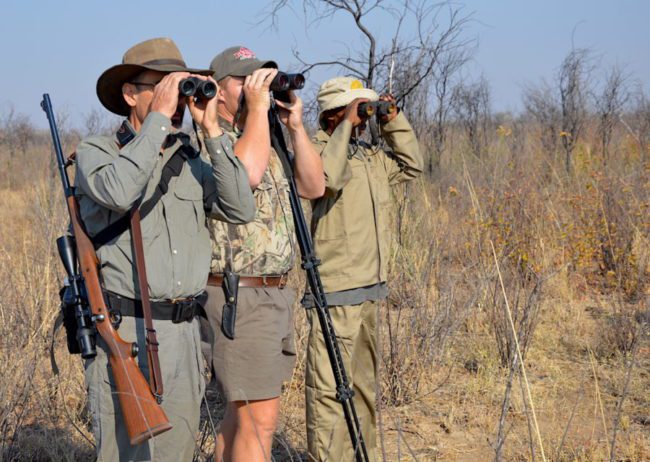
Over the next five days we saw two good bulls, but each time we were unable to close the deal. Rainfall has been sparse in Limpopo of late. Dry leaves littered the ground and stalking over the rocky soil was akin to trying to sneak across a bowl of marbles and cornflakes.
Every day we climbed into the safari car and headed out into the vast reaches of the bush. Every day we passed other game in great numbers while looking for nyala. And every day I resisted the temptation to take one of the big kudu and eland that we saw.
Often, in our ramblings, the hair on the back of my neck would prickle, as if we were being watched by someone or something, and I would see baboons on the cliffs above. There was one old male that we saw on several occasions, looking down on us as we rumbled by his ridge on our way to some far place. He sat alone on the same rocky prominence and had the aloof demeanor of one to whom all things were known. Once, he propped his chin upon his hand, in emulation of Rodin’s enigmatic The Thinker, and I couldn’t help but feel how eerily human he looked and how, in some way or other, the spirits of the ancients were always with us.
Day by day, night by night, the moon waxed and its rise came nearer and nearer to coinciding with dusk. Along toward evening on the fifth day, we were slowly creeping along a soft sand trail adjacent to a small creek bed where we had seen a big bull a couple of days before. The wind was light, and the evening had started to chill slightly. The full moon rose behind us and game began to move.
Suddenly, Jimmy whispered “nyala,” and Theuns confirmed the call with, “that’s him.” All I could see was legs in the thorn, but as we eased forward, a good bull came into focus. He was standing deep in the thorn with a couple of females, frozen in place, watching us pass. A couple of hundred yards along, Theuns tapped on the roof of the vehicle, and as it rolled to a stop, we slipped over the side.
Conditions were perfect for the stalk. The breeze was crossing, right to left. This time, the sandy road was devoid of leaves or rocks, and we made no sound as we retraced our path to where we’d seen the bull. When we found the spot, the nyala had resumed feeding and were completely unaware of our presence.
The rifle steadied over the sticks, but the bull had his head in the bush and there was no chance for a clean shot. Darkness was coming quickly and as we waited, we were losing precious light. All I could see in the scope was the crosshair against a jumble of black. Branches rambled in all directions. There was nothing to do but wait.
Finally the bull took a couple of steps forward, outlining his neck and shoulder through a break in the brush and when the shot broke clean, he bolted into a headlong rush before clumping onto the sand. We memorialized the event in near dark, with the full moon rising behind us.
That evening over dinner we decided to use my remaining time to hunt for kudu. I had a couple of days left, and we had been seeing big kudu every day for a nearly a week. Of course, the next day the big kudu were reclusive, and we saw nothing but cows and immature bulls.
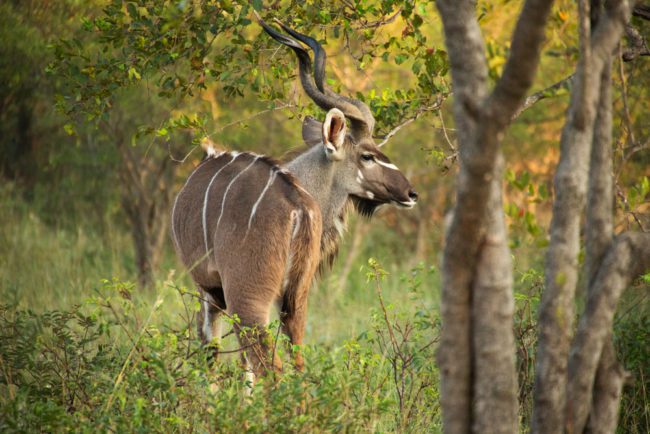
The last day began that way too. Then toward dusk, Theuns spotted a lone kudu cow standing back in the thorn. We had just come down a long ridge that slithered snake-like from the top of the big plateau to the plain below. At the bottom was a small waterhole where we had seen kudu several times, and we found them there again.
It turned out there were six kudu in the herd, including a respectable bull. But before I could get a shot, the animals crashed away, climbing diagonally up the side of the ridge, disappearing into the brush. There was nothing to do but try to keep up with them and hope for a break.
We spent the next half-hour alternately crouching in the brush and running from cover to cover while the kudu continued angling upward in the twilight. Finally, we came up even with them, about 200 yards away, but before I could get set, the group broke into a trot, dodging in and out of the brush. When they had gone about 40 yards, a couple of the cows passed through an opening. Slowly I counted three cows, four, then five.
When the bull came into the opening, the trigger break came of its own accord, and when the bull ran, we ran, too. In a couple of minutes, the cows came into the open far above us, but this time there was no bull. After a short scramble to the spot where we last saw him, we found him down among the rocks. Again, we rushed to get the mandatory “hero shots” before the dark overtook us.
On that, my last night at Ekland, we held a celebration. It was a celebration of the hunt, of friends old and new. Of good times and grand places, old and new. On a small plateau, perched upon the sheer side of a tall hill, we built a bonfire, and the fire wrestled with the light of the full moon for the right to cast shadows upon the cliff above. We ate and drank and toasted each other and the nyala and the kudu, and to times still to come. And the spirits of the ancients came again to oversee us from the cliffs.
I think that I gained a new perspective from this trip. It grew from the incongruity of the accommodations. There is, of course, a place for a traditional tented safari in remote bush. There is also a place for comfort in the midst of the African bush. Africa is still itself. There is no shortage of adventure, regardless of whether you choose a traditional tented safari in deep bush or a luxury lodge on the fringe of civilization.
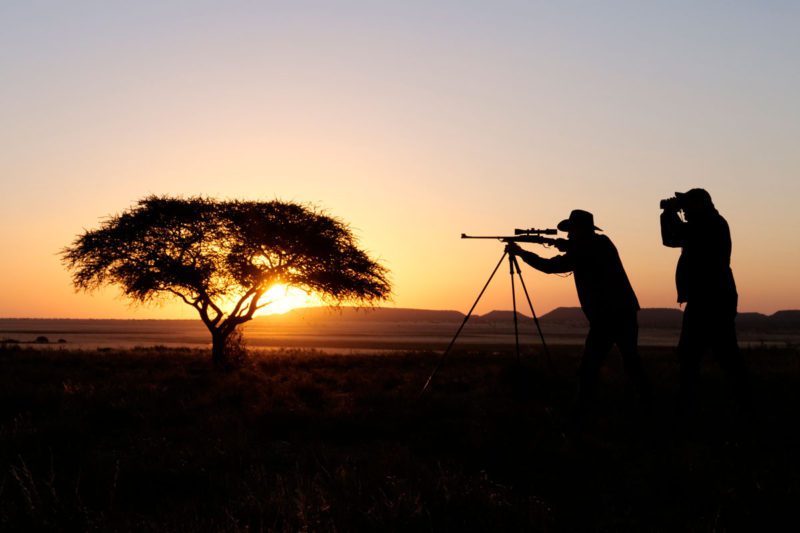
My approach to African hunting may seem odd to some, but it allows me to savor the experience, to smell and taste Africa, to drink the last drop, and leave nothing in the bottle. I go to Africa to experience the hunt. Not to kill.
To paraphrase Jose Ortega y Gasset’s words, I kill only that I may have hunted. I kill only enough to validate the hunt, to secure its bona fides, and to make it real. I think it sad that so many are lured to Africa by the mystique but allow themselves to become so engaged in body counting that it dilutes the experience and consumes its essence.
If Ortega y Gasset’s words are true, do we not benefit from killing less and thereby hunting more?
In the light of the fire on that last night, I discovered that I had once again engaged in self-delusion, and that it was perhaps not about the nyala at all. Perhaps the nyala is the totem, the shaman’s symbol for the place and people and spirits that I so dearly love. And perhaps the nyala merely provided a reason to be there, to caress another part of Africa and love her all over again, for the unrepentant dreamer to be once more in the birthplace of our kind, where man first gazed into the night sky and was awed by what he saw and humbled by his own insignificance and swore, “I will be more.”
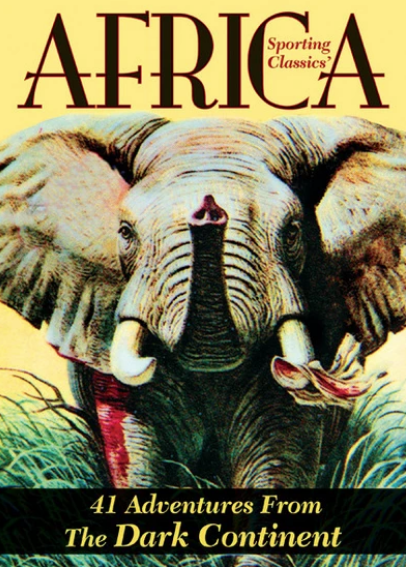
Sporting Classics has compiled this remarkable anthology showcasing the best African adventures published in our award-winning magazine.
Ruark, Capstick, Roosevelt, Markham – the legends in outdoor literature are all here, sharing their stories of deadly encounters with dangerous game, of bizarre run-ins with witch doctors, gorillas and man-eaters, of safaris into the uncharted wilds of deepest Africa.
Illustrated by world-renowned artist Bob Kuhn, AFRICA features more than 400 pages of unforgettable stories by some of the finest professional hunters and writers of sporting adventure. Buy Now

